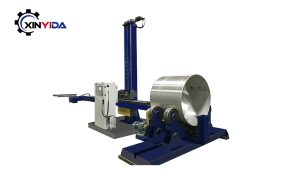In the modern industrial landscape, efficiency is paramount. Companies across various sectors are continually seeking innovative solutions to optimize their production processes. One such solution that has gained traction is the tank polishing machine. These specialized machines not only streamline operations but also enhance the quality of the finished product, making them invaluable in many industries.

XINYIDA tank and dished ends polishing machine
-
What is a Tank Polishing Machine?
A tank polishing machine is designed to clean and polish the interior surfaces of tanks, vessels, and other large containers used in manufacturing processes. Commonly utilized in the food and beverage, pharmaceutical, and chemical industries, these machines effectively remove residues, contaminants, and oxidation from the surfaces of tanks, ensuring they meet stringent hygiene and quality standards.
-
Key Benefits of Tank Polishing Machines
- Improved Production Quality
One of the primary advantages of using a tank polishing machine is the significant improvement in product quality. In industries where hygiene is critical, such as food and pharmaceuticals, any residue or contaminant can compromise the safety and quality of the end product. By ensuring that tanks are thoroughly polished and free of contaminants, these machines help maintain high standards and reduce the risk of product recalls or safety issues.
- Enhanced Efficiency
Traditional methods of tank cleaning and polishing can be labor-intensive and time-consuming. Manual cleaning often requires multiple workers and considerable downtime, which can lead to reduced productivity. In contrast, tank polishing machines automate much of the cleaning process, significantly decreasing the time required to prepare tanks for production. This efficiency not only reduces labor costs but also allows companies to maximize production output.
- Consistent Results
Consistency is crucial in industrial production. Variations in cleaning quality can lead to discrepancies in product quality. Tank polishing machines provide uniform cleaning and polishing results, ensuring that all tanks are treated the same way. This consistency is vital for maintaining brand integrity and meeting regulatory standards.
- Reduced Labor Costs
By automating the polishing process, businesses can reduce their reliance on manual labor, which can be both costly and prone to human error. Tank polishing machines require less manpower, allowing workers to focus on other critical tasks. This reallocation of labor not only improves overall efficiency but also reduces operational costs, contributing to a healthier bottom line.
- Environmentally Friendly Operations
Many modern tank polishing machines are designed with sustainability in mind. They often use less water and cleaning agents than traditional methods, minimizing waste and environmental impact. By adopting such technologies, companies can enhance their sustainability initiatives while also improving their operational efficiency.

tank shell polishing machine
-
Conclusion
Incorporating tank polishing machines into industrial production processes represents a strategic investment in efficiency and quality. By automating and streamlining the cleaning and polishing of tanks, these machines help companies enhance product quality, improve production efficiency, ensure consistency, and reduce labor costs. As industries continue to evolve, embracing innovative technologies like tank polishing machines will be essential for staying competitive and meeting the demands of an increasingly quality-conscious market.
For businesses looking to boost their productivity and maintain high standards, investing in a tank polishing machine could be the key to unlocking greater efficiency and success in their operations.
If you want to know more about the tank polishing machine, please contact Xinyida for detailed ordering information.
